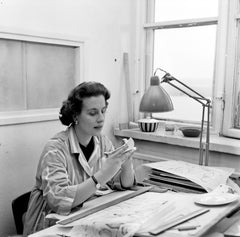Finland's representative ceramic maker ARABIA company. Arabia comes from the Arabian district in the capital Helsinki. There is still a factory here, and it seems that for a while it was possible to tour the factory, but now it has been renovated into a design center and is a direct sales store for Iittala products.

(Mamezara handed out during the factory tour)
Originally ARABIA started as a Finnish factory of Rorstrand in Sweden. In 1873, when the company was founded, it was a territory of Imperial Russia, so exporting tableware from Sweden was subject to customs duties, so it seems that building a factory in Russia also meant avoiding taxes.
At that time, Meissen-style tableware was manufactured with many traditional European bone china decorations. In Northern Europe, the artistic movement that occurred in the middle of the 20th century, called mid-century, led to what is now called "Nordic Modern."
Before that, there were many dishes like Meissen's reheated dishes, and there was no originality or independence in design. However, from around the 1940s, a unique Nordic design sense was gradually created, and it was concentrated around the 1950s to 1970s that it blossomed. Tableware produced at this time is Gustavsberg's Versa and ARABIA's Valencia.
Scandinavian design is characterized by its simplicity and beauty. In Valencia, a painter called a painter colors each tableware by hand painting. To put it in extreme terms, it's just a cobalt blue paint, but the point is that the color is exquisitely deep and not too black.
Basically, a pattern is specified for the design, with a plate having a floral pattern in the center and a spiral pattern around it, a soup plate having a more detailed petal in the center, and a cup having a wall pattern. It features a lattice pattern.

(You can see that there were various patterns in Valencia)
Recently, rare dishes have arrived. Valencia was released in 1961, but it is a prototype that seems to have been made the night before.
There is a mixture of floral and lattice patterns, and it seems that this kind of thing was also on the market for a while. Looking at how it was made, there is no signature on the back, and it is a prototype of a prototype because it is sweet and crunchy. This is probably because the ones without the painter's signature on the back were not for sale.

(Only one sign is UP)
Some plates have an UP sign on the back. This indicates that the design itself is Ulla Procoppe's own. The UP is usually separated by a slash and signed by the painter's initials. The fact that there is only UP indicates that it was one of the patterns devised by Ulla Procoppe himself. He may have actually taken the paintbrush.

In the end, the Valencia series was a deformed version of the previous year's Fiesta, with flowers, swirls, and straight lines interspersed in the design.
Valencia, which was named as Chinami series name, is the name of a port town in southeastern Spain. The dark cobalt blue used in the glaze is said to represent the dull color of the Mediterranean sea and the strong sunlight.
Designed in 1961, Valencia was manufactured in Finland for over 40 years until 2002. Since then, it has not been reprinted, and the only ones currently available are those on the vintage market. The later works still retain the hand-painted elements, but the back stamp on the back has been changed to a stamp instead of handwriting.
Ulla Procoppe died of illness in 1968 at the young age of 47, but she was recuperating in the Canary Islands in Spain, and I feel that her heart was always overflowing with love for Spain. Northern Europe is a country with very cold winters, and I think that there is a kind of longing for southern Europe with a warm climate as a culture of begging for things.
Speaking of Northern Europe, Japan is often referred to as a happiness ranking or discussed as a utopia. Winter is especially cold and the sun is extremely short, so we strongly recommend visiting around the summer solstice, known as midsummer.
Nakamura

